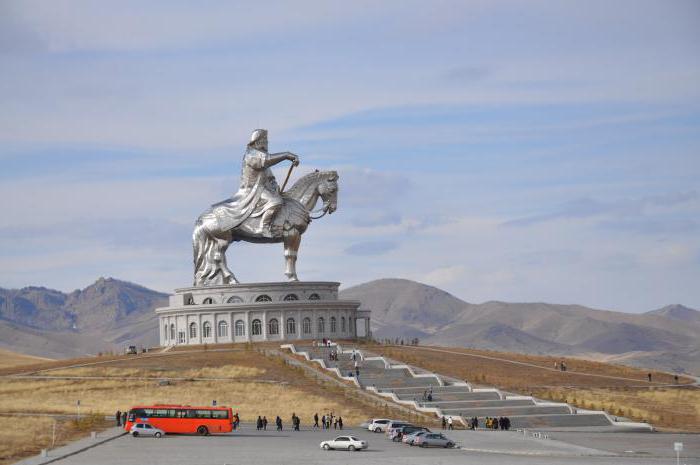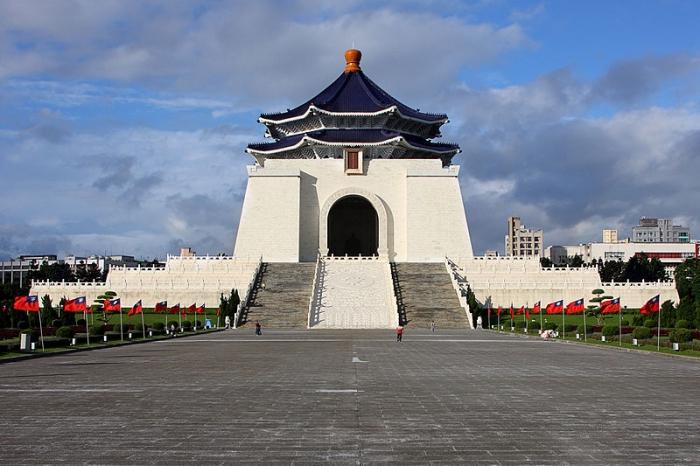Mongolia (Republic): the capital, attractions
The country is located in the heart of Asia. This is a territory of vast steppes, sand dunes, vast mountains, endless blue sky and hot sun. Magnificent Mongolia owns fabulous natural resources.
Answers to many questions related to thisbeautiful country, can be found in this article. In it we will talk about the state structure (Mongolia is a republic or a monarchy); about a geographical position, about the population and many other things.
A lot of interesting can tell the centuries-old history of Mongolia. Features of the ancient traditions and customs are quite curious and diverse.

general information
Total Mongolia has 250 sunny days per year.
This mysterious country, often called the "Country"blue sky ", is the birthplace of the great conqueror of Genghis Khan. Rocky mountains, blue lakes, boundless steppes and golden sands of the Gobi Desert are all beautiful Mongolian natural landscapes. There are many Buddhist temples here, surprisingly hospitable locals with their unique and original culture.
Government structure
Is Mongolia a republic or a state?
The highest legislative authority of Mongolia -The Great Khural (Parliament). In the unicameral parliament there are 76 members (under the Constitution) with powers for a four-year term. By popular vote, a parliament is elected, the main form of activity of which are sessions that sit only if there are 2/3 or more of its members.
In the powers of parliament - the formation of the highestexecutive power in Mongolia (the government headed by the Prime Minister). The head of state is the president, who can be elected from Mongolian citizens who have reached the age of 45 for a period of 4 years (the condition is a permanent residence in the homeland for the last 5 years).
According to the Constitution, in force since 1992,Mongolia is a parliamentary republic. The main political parties are: the People's Revolutionary Party, the Democratic Party, the Democratic Religious Party and the Green Party.
Until 1992 the country was called the Mongolian People's Republic.
In 1991, the Democratic Party came to power in the course of a peaceful revolution. Since 2009, the country has carried out many reforms.
Geographical position
This country is a part of Central Asia.
Mongolia is a republic that has no access to the sea. The border has with Russia in the north, in the south, west and east - with China. The entire length of the borders of Mongolia is 8,162 kilometers (including 3,485 km with Russia).
The territory of the state is 1,566 thousand square kilometers.

Territorially the Republic of Mongolia is divided into 21region (aimak), consisting of smaller administrative units - Somon. In turn, each somon (total 342) is divided into bugs (brigades). There are 1539 in total.
3 Mongolian cities Erdenet, Darkhan and Choir are autonomous units by status.
The Gobi Desert extends to the south of Mongolia andborders on China. The Altai Mongolian mountain system stretches from the west of the state to the southwest. The highest peak is the peak Kuyten-Uul (4 374 meters).
Several large rivers flow through the territory of Mongolia: Onon, Selenga, Tesin-Gol, Kerulen, Khalkhin-Gol, etc.
Capital
A wonderful ancient city full of monumentshistory, has Mongolia (republic). The capital of Ulaanbaatar (in the local Ulaanbaatar writing) contains more than 1 million 300 thousand inhabitants. It should be noted that several times the capital of this republic was renamed and moved.
Ulan-Bator was formed in the XVII century (1639). Earlier there were the capitals: Urgo (1639-1706), Their Khuree (1706-1911), Niyslal Khuree (from 1911 to 1923) and Ulan Bator (since 1924).

Previously, on the site of this city was a Buddhist monastery.
Population, languages
The Mongols make up 85% of the total population of the country,7% - Kazakhs, more than 4.5% - durvuds and more than 3% - representatives of different ethnic groups. And beyond Mongolia live more than 4 million people of Mongolian nationality.
The total population at the beginning of 2009 is approximately 2 million 700 thousand people.
The official language is the Mongolian (Ural-Altaic family).

A bit of history
Mongolia is a republic in which the customs and traditions of the population are rooted in the most ancient peoples, once inhabiting the territory of Central Asia.
Many customs are echoes of the ancientsBuddhist and shamanic rituals, in which religious purpose and content were lost in time. However, some ritual acts are still observed by local residents.
There are many beliefs and bans that have common Central Asian roots. Therefore, they are the same for the Buryats and for the Mongols.
In addition, it should be noted that many Mongolsstill keep and honor the ancient customs of nomadic life, and now they live in felt yurts and exist due to the management of a generic subsistence farm.
In general, people in the territories of Mongolia appeareda long time ago, many thousands of years ago. From ancient prehistoric times it is inhabited by nomads, who periodically formed various state confederations. The Chinese built the famous Great Wall precisely because of those most ancient Mongols.

How did it all begin?
Mongolian leader named Temujin in 1206He acquired the title of Genghis Khan and won a number of countries and peoples. So the Mongol Empire appeared. After the death of Genghis Khan, it was divided into four khanates. In those days, the empire was located in the territories from Korea to Poland, and from Vietnam in the south to Siberia in the north.
Since the XVI century in Mongolia began to spread Buddhism after frequent internecine wars for power and the invasion of Chinese troops.
Mongolia was controlled by the Chinese Qing dynasty until 1911.
So, is Mongolia a republic or not?
The Mongolian People's Republic, which was friendly to the USSR, was established in 1924.
And since 1992, officially the Mongolian People's Republic began to be called Mongolia.
Religion
Mongolia is a republic dominated byBuddhism of Mahayana (94%), shamanism on its northern part and Islam (4%) - on the western side. Only in the twentieth century the country had many Buddhist monasteries - several hundred, and approximately 30% of the male population were monks.
In Mongolia from the thirties of the same centuryAn anti-religious campaign was launched, which virtually destroyed a huge system of monasteries. Many were closed, and some were looted and destroyed. However, after certain democratic changes (90th), freedom of religion was declared. The monasteries started their activities again. Today there is even an Orthodox church in Ulan Bator. The Republic of Mongolia is unique in terms of religion.
sights
In the great ancient Mongolia, a hugea lot of unique archaeological and historical-architectural monuments. Near the river. Chultyn-Gol is the oldest Neolithic drawings under the protection of UNESCO.

Also in the top 10 of the best Mongolian attractions you can include the following:
- the famous Bell of Peace, located in Ulan Bator;
- the great Mausoleum of Sukhbaatar (also in the capital);
- Khan's palace with magnificent sculptures of Tara (goddess) in the capital of Mongolia;
- Monastery Gandan.
Culture
Mongolia - republic, traditions and culturewhich are rich and diverse. Nomads for many centuries wandered through deserts and steppes of Central Asia and kept certain customs in the unchanged form. Every July in Mongolia, the Naddam holiday is celebrated with traditional Mongolian competitions in horse racing, archery and wrestling; the end of winter time and the arrival of the New Year are celebrated, too, with competitions.

In Mongolia, various festivals are held: Hunting eagles; Yaka and the camel.
In conclusion about the economy
Mongolia is developing dynamically in the economic sphere and is one of the most promising markets in Northeast Asia, and practically in the entire Asia-Pacific region.
</ p>




